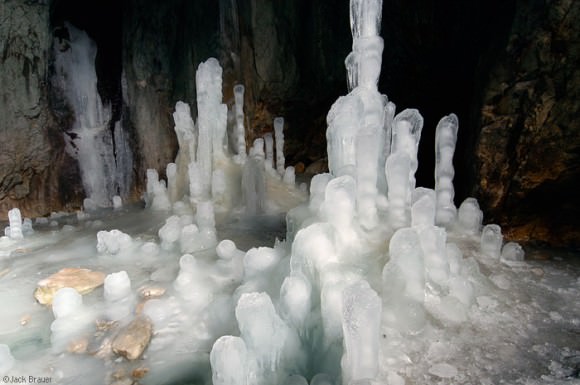[/caption]
New results published in the journal Icarus suggest that caves on Mars may provide future astronauts with more than just shelter. In many locations, even far from the poles, the caves may actually trap water ice.
Ice caves are made of rock, but they contain ice year-round. (Not to be confused with glacier caves, which are caves made of ice!) Ice caves can be found on the Earth even where surface temperatures are above freezing for months at a time. This happens because cold winter air sinks into the cave and is trapped, but during the summer, the circulation in the cave shuts off: it is full of dense cold air so the warm air outside can’t get in.
Now, in a study led by Kaj Williams of NASA Ames, scientists have used simulations of the global climate and assumptions about the thermal properties of the surface to figure out where on Mars similar cold-trapping might occur. Their results show that a significant portion of the martian surface has the right conditions for ice to accumulate in caves.
Even more tantalizing, the huge volcanic provinces of Tharsis and Elysium look to be particularly good at accumulating ice. This is important because caves formed by collapsing lava tubes have been seen on the flanks of these volcanoes. Lava tube caves on Earth tend to have limited air circulation, making them good candidates for ice accumulation.
Astronauts on the surface of Mars will likely need to take cover underground to avoid the harsh radiation environment of the surface. Natural caves such as lava tubes have been suggested as ideal ready-made shelters for astronauts, and they are only looking better. Not only could ice caves provide water as a resource, the ice could preserve valuable records of past climate cycles, and the caves may be important habitats for past or present martian life.
Williams and his team plan to continue refining their models, particularly focusing on the Tharsis and Elysium regions, using higher-resolution atmospheric models and more precise geologic data to pinpoint areas that are best for cave-ice formation.



I like! Thanks for the update Ryan…
Upon revisiting the images posted, I note that the image on the lower right has an interesting feature. That is the lighter colored material directly above the ‘hole’. Could it simply be an artifact of wind transporting dusty material, or possibly due to some sort of out-gassing? or heat escaping?
Hi
These look to be shadows. Is there some kind of ground penetrating technology at work here?
Finding caves on Mars would be amazing! Purely for their preservative characteristics.
Interesting…
Ice traps, like the Moons south pole craters. nature never cease to amaze.
@ dalebotha:
Assuming I understand your question correctly, those shadows _are_ actual cave openings found from collapsed lava tubes, as the article says. You can see the sunlit roof edge on one side of some, and IIRC there are estimates of several tens of meters depth of the tubes.
Lava tube cave openings are observed on Earth, and even the Moon now as it is mapped on a sufficiently resolved scale.
Dunno about Venus, dunno about how much its radar mapping affects resolution vs optical photos.
Mercury should result in some more, as soon as the close mapping starts…
@Torbjorn Larsson OM – “Mercury should result in some more, as soon as the close mapping starts…”
Once again… you are ON IT! Very interesting concept… a lil ol ‘hidey hole’ on Mercury might come in handy, some day…
Ice caves? I doubt it. I know an ACME portable hole when I see one. Particularly the last one (bottom right).